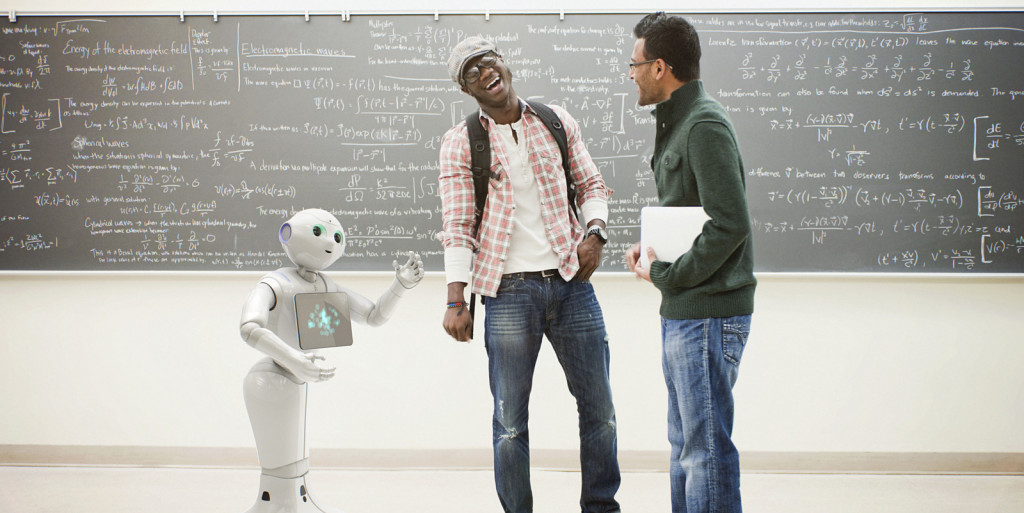** This post was originally published in ACRL TechConnect on Oct. 12, 2015.***
The movie, Robot and Frank, describes the future in which the elderly have a robot as their companion and also as a helper. The robot monitors various activities that relate to both mental and physical health and helps Frank with various house chores. But Frank also enjoys the robot’s company and goes on to enlist the robot into his adventure of breaking into a local library to steal a book and a greater heist later on. People’s lives in the movie are not particularly futuristic other than a robot in them. And even a robot may not be so futuristic to us much longer either. As a matter of fact, as of June 2015, there is now a commercially available humanoid robot that is close to performing some of the functions that the robot in the movie ‘Frank and Robot’ does.
A Japanese company, SoftBank Robotics Corp. released a humanoid robot named ‘Pepper’ to the market back in June. The Pepper robot is 4 feet tall, 61 pounds, speaks 17 languages and is equipped with an array of cameras, touch sensors, accelerometer, and other sensors in his “endocrine-type multi-layer neural network,” according to the CNN report. The Pepper robot was priced at Â¥198,000 ($1,600). The Pepper owners are also responsible for an additional Â¥24,600 ($200) monthly data and insurance fee. While the Pepper robot is not exactly cheap, it is surprisingly affordable for a robot. This means that the robot industry has now matured to the point where it can introduce a robot that the mass can afford.
Robots come in varying capabilities and forms. Some robots are as simple as a programmable cube block that can be combined with one another to be built into a working unit. For example, Cubelets from Modular Robotics are modular robots that are used for educational purposes. Each cube performs one specific function, such as flash, battery, temperature, brightness, rotation, etc. And one can combine these blocks together to build a robot that performs a certain function. For example, you can build a lighthouse robot by combining a battery block, a light-sensor block, a rotator block, and a flash block.

A variety of cubelets available from the Modular Robotics website.
By contrast, there are advanced robots such as those in the form of an animal developed by a robotics company, Boston Dynamics. Some robots look like a human although much smaller than the Pepper robot. NAOÂ is a 58-cm tall humanoid robot that moves, recognizes, hears and talks to people that was launched in 2006. Nao robots are an interactive educational toy that helps students to learn programming in a fun and practical way.
Noticing their relevance to STEM education, some libraries are making robots available to library patrons. Westport Public Library provides robot training classes for its two Nao robots. Chicago Public Library lends a number of Finch robots that patrons can program to see how they work. In celebration of the National Robotics Week back in April, San Diego Public Library hosted their first Robot Day educating the public about how robots have impacted the society. San Diego Public Library also started a weekly Robotics Club inviting anyone to join in to help build or learn how to build a robot for the library. Haslet Public Library offers the Robotics Camp program for 6th to 8th graders who want to learn how to build with LEGO Mindstorms EV3 kits. School librarians are also starting robotics clubs. The Robotics Club at New Rochelle High School in New York is run by the school’s librarian, Ryan Paulsen. Paulsen’s robotics club started with faculty, parent, and other schools’ help along with a grant from NASA and participated in a FIRST Robotics Competition. Organizations such as the Robotics Academy at Carnegie Mellon University provides educational outreach and resources.

Image from Aldebaran website at https://www.aldebaran.com/en/humanoid-robot/nao-robot
There are also libraries that offer coding workshops often with Arduino or Raspberry Pi, which are inexpensive computer hardware. Ames Free Library offers Raspberry Pi workshops. San Diego Public Library runs a monthly Arduino Enthusiast Meetup. Arduinos and Raspberry Pis can be used to build digital devices and objects that can sense and interact the physical world, which are close to a simple robot. We may see more robotics programs at those libraries in the near future.
Robots can fulfill many other functions than being educational interactive toys, however. For example, robots can be very useful in healthcare. A robot can be a patient’s emotional companion just like the Pepper. Or it can provide an easy way to communicate for a patient and her/his caregiver with physicians and others. A robot can be used at a hospital to move and deliver medication and other items and function as a telemedicine assistant. It can also provide physical assistance for a patient or a nurse and even be use for children’s therapy.
Humanoid robots like Pepper may also serve at a reception desk at companies. And it is not difficult to imagine them as sales clerks at stores. Robots can be useful at schools and other educational settings as well. At a workplace, teleworkers can use robots to achieve more active presence. For example, universities and colleges can offer a similar telepresence robot to online students who want to virtually experience and utilize the campus facilities or to faculty who wish to offer the office hours or collaborate with colleagues while they are away from the office. As a matter of fact, the University of Texas, Arlington, Libraries recently acquired several Telepresence Robots to lend to their faculty and students.
Not all robots do or will have the humanoid form as the Pepper robot does. But as robots become more and more capable, we will surely get to see more robots in our daily lives.
References
Alpeyev, Pavel, and Takashi Amano. “Robots at Work: SoftBank Aims to Bring Pepper to Stores.†Bloomberg Business, June 30, 2015. http://www.bloomberg.com/news/articles/2015-06-30/robots-at-work-softbank-aims-to-bring-pepper-to-stores.
“Boston Dynamics.†Accessed September 8, 2015. http://www.bostondynamics.com/.
“Finch Robots Land at CPL Altgeld.†Chicago Public Library, May 12, 2014. https://www.chipublib.org/news/finch-robots-land-at-cpl/.
McNickle, Michelle. “10 Medical Robots That Could Change Healthcare – InformationWeek.†InformationWeek, December 6, 2012. http://www.informationweek.com/mobile/10-medical-robots-that-could-change-healthcare/d/d-id/1107696.
Singh, Angad. “‘Pepper’ the Emotional Robot, Sells out within a Minute.†CNN.com, June 23, 2015. http://www.cnn.com/2015/06/22/tech/pepper-robot-sold-out/.
Tran, Uyen. “SDPL Labs: Arduino Aplenty.†The Library Incubator Project, April 17, 2015. http://www.libraryasincubatorproject.org/?p=16559.
“UT Arlington Library to Begin Offering Programming Robots for Checkout.†University of Texas Arlington, March 11, 2015. https://www.uta.edu/news/releases/2015/03/Library-robots-2015.php.
Waldman, Loretta. “Coming Soon to the Library: Humanoid Robots.†Wall Street Journal, September 29, 2014, sec. New York. http://www.wsj.com/articles/coming-soon-to-the-library-humanoid-robots-1412015687.

